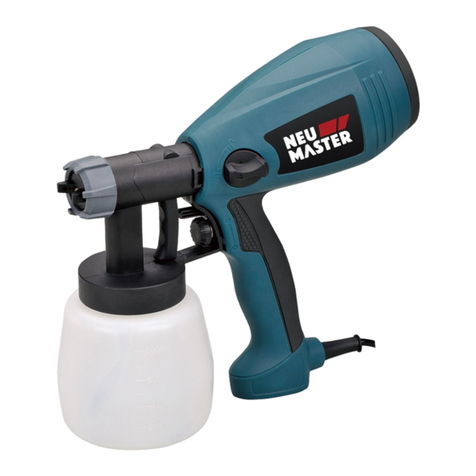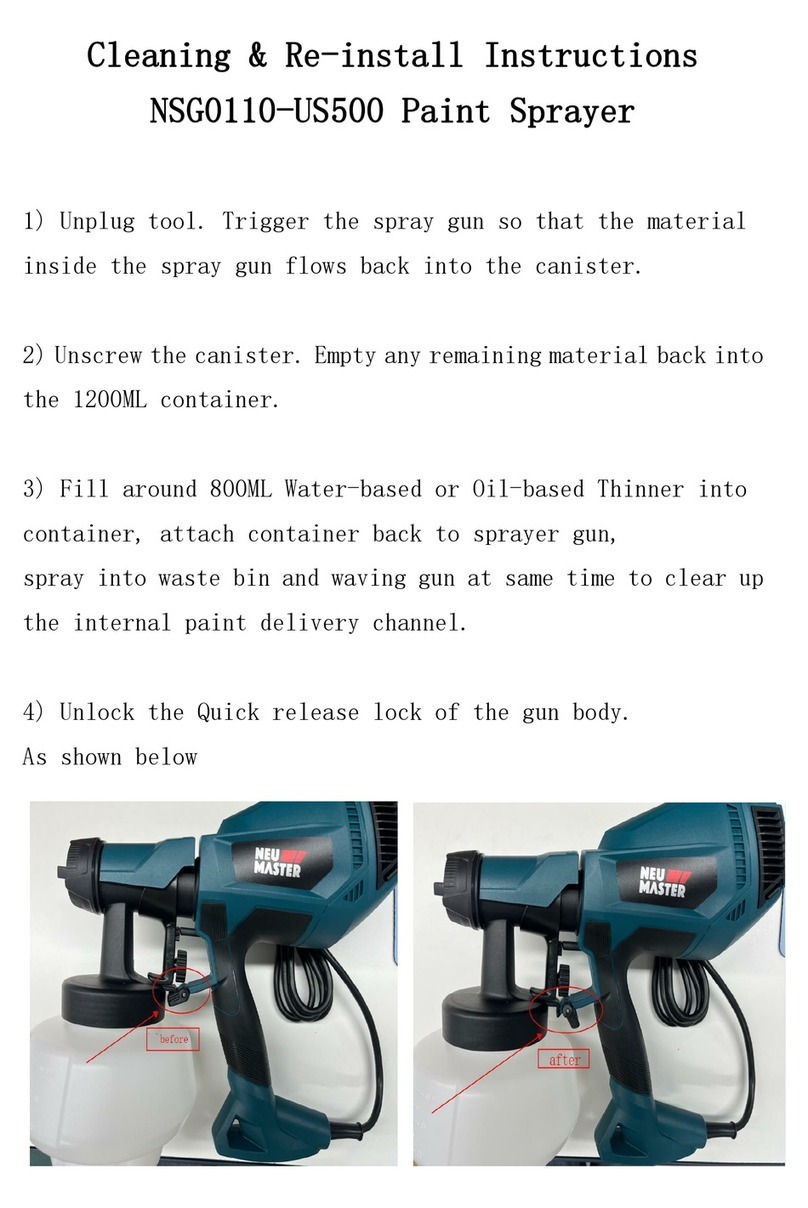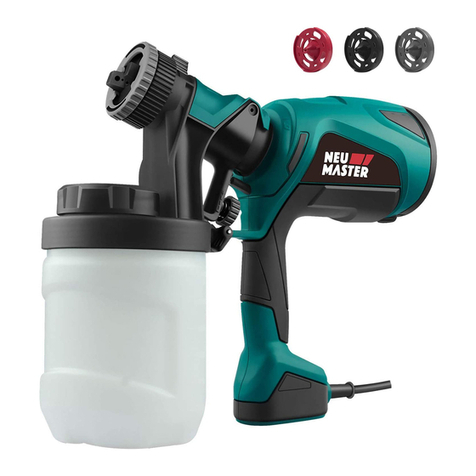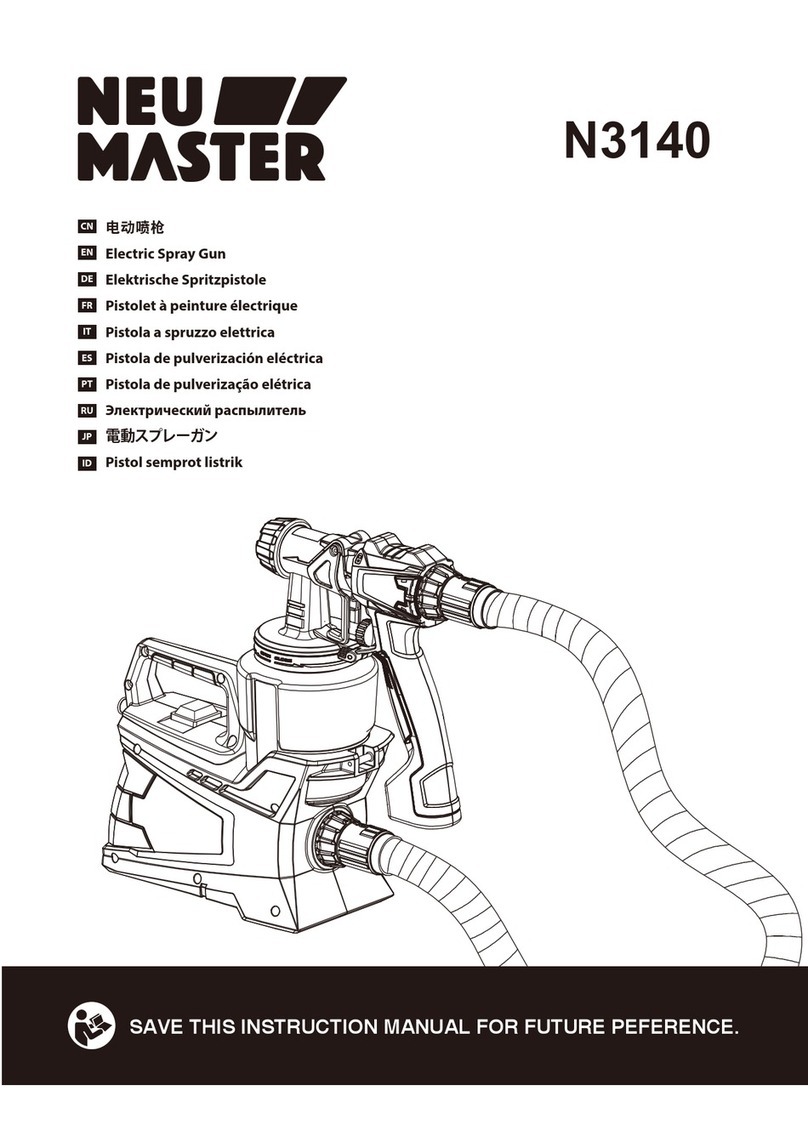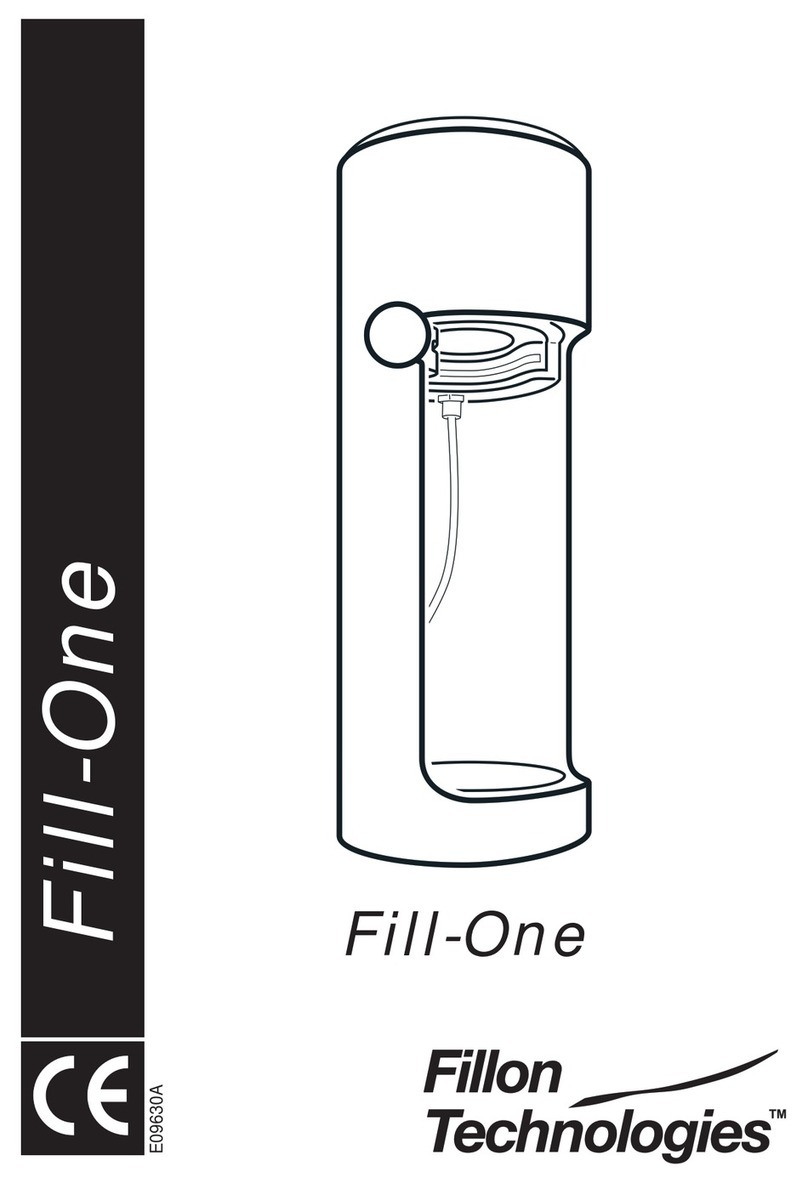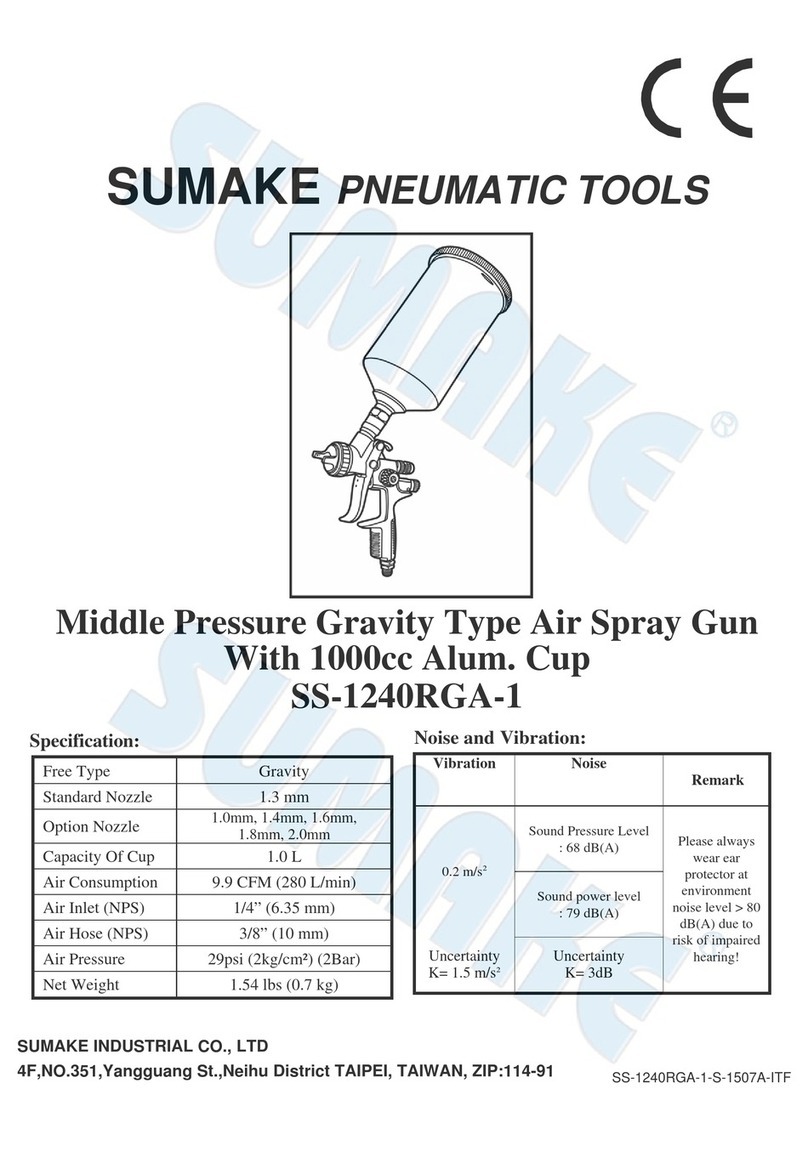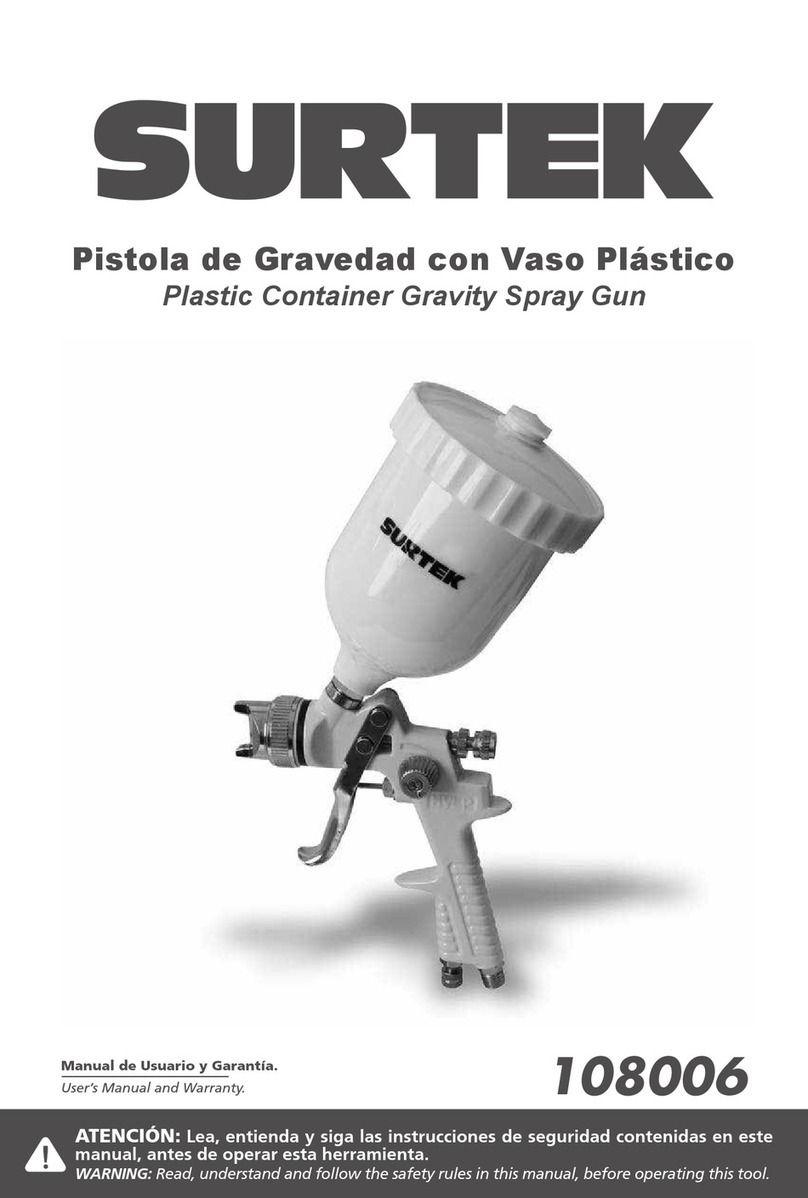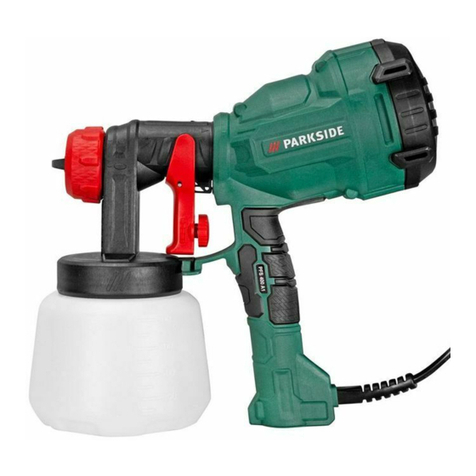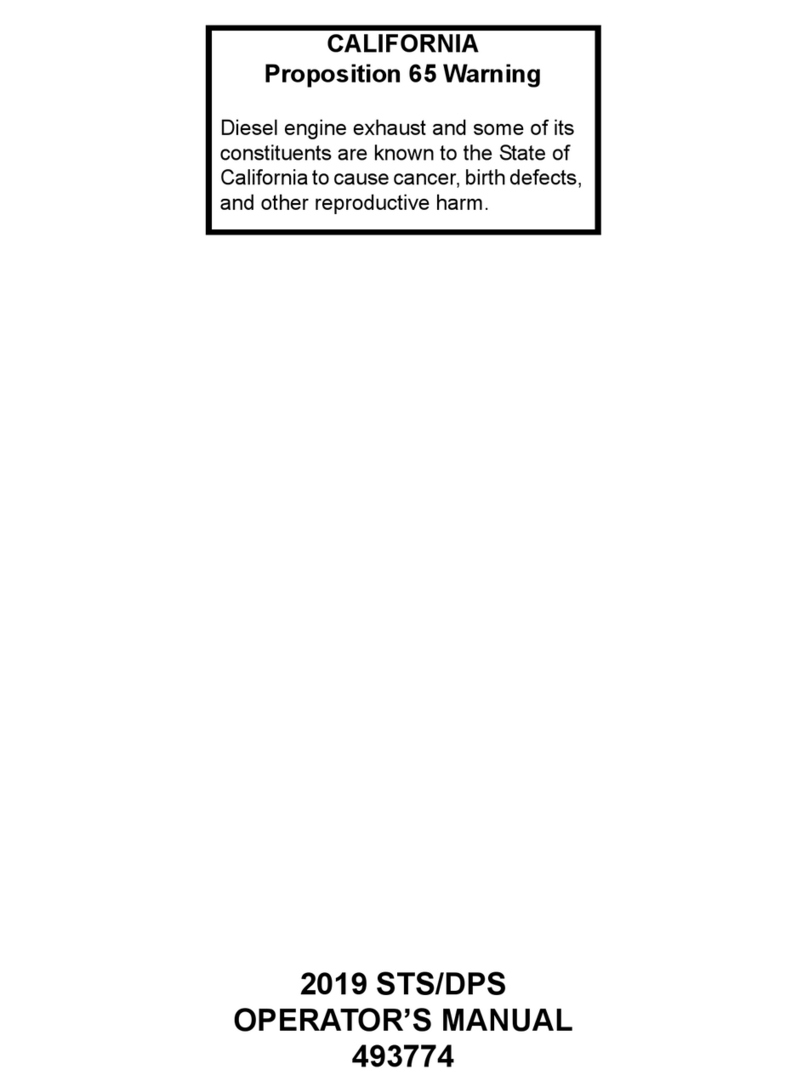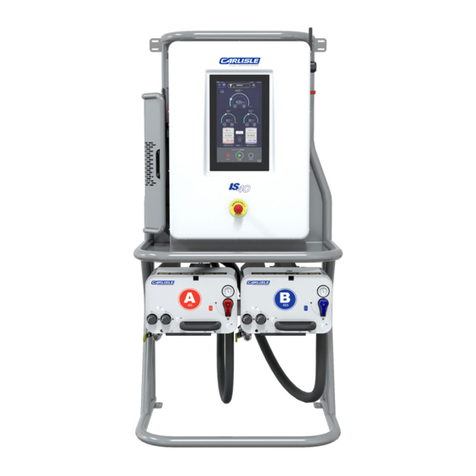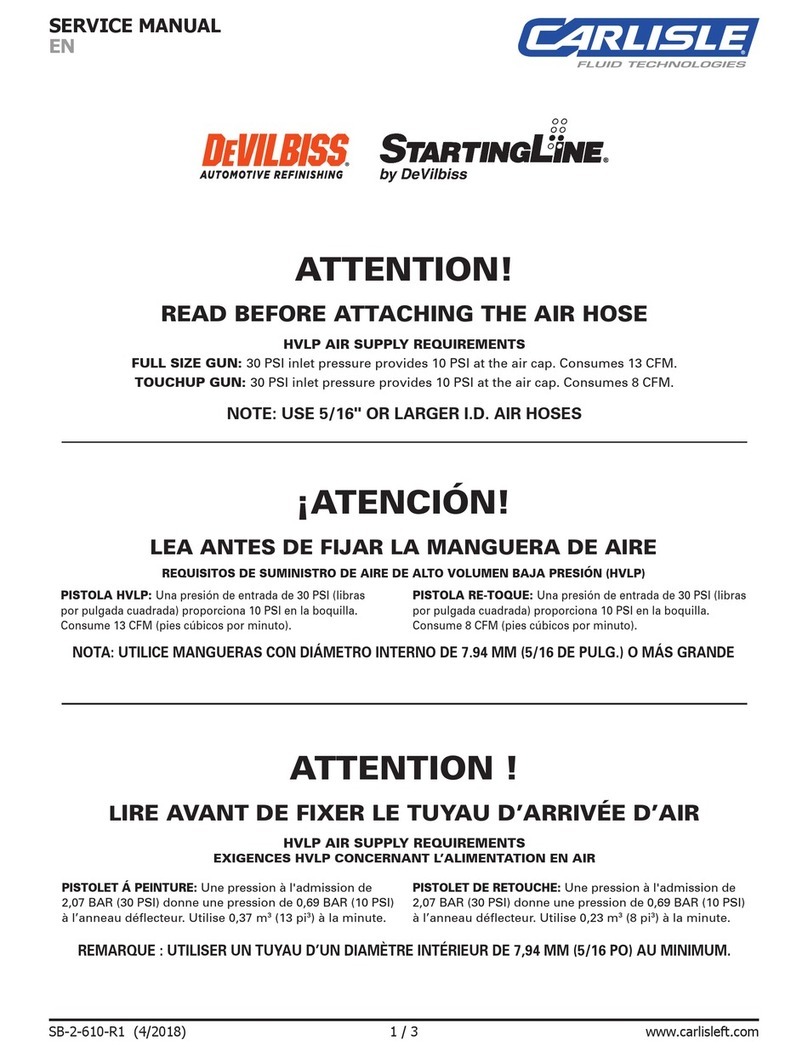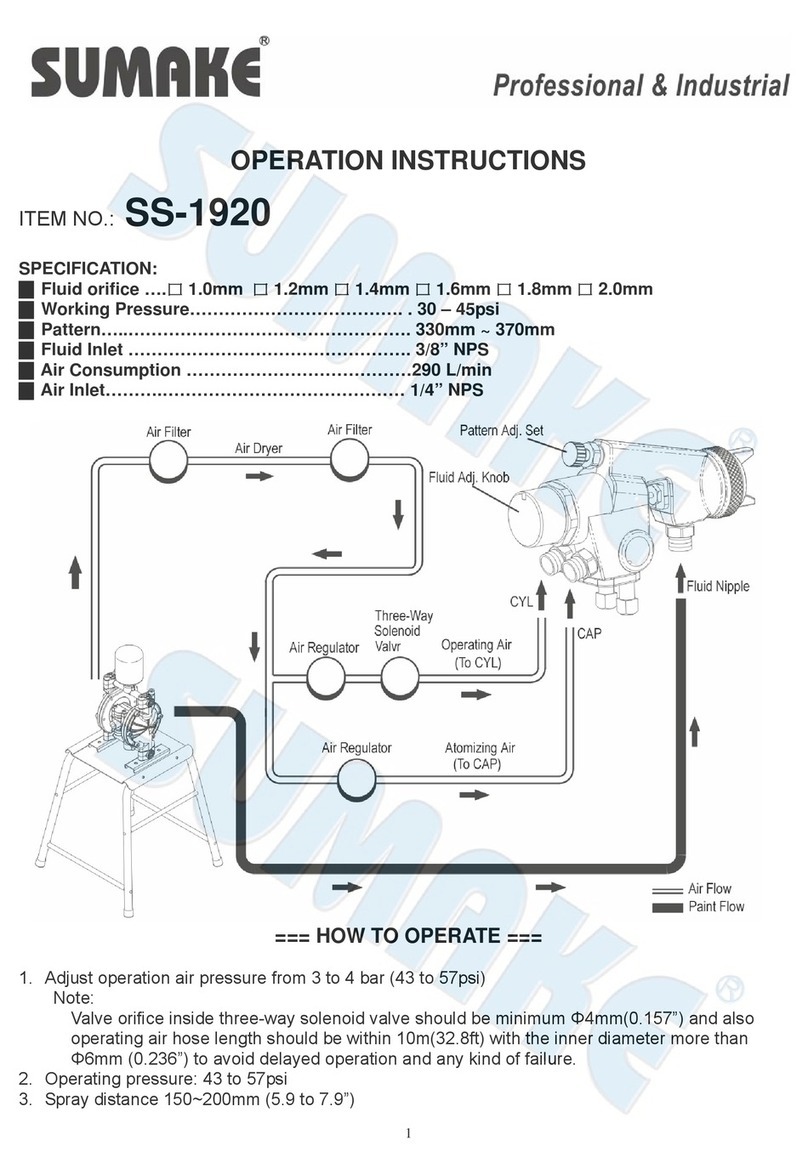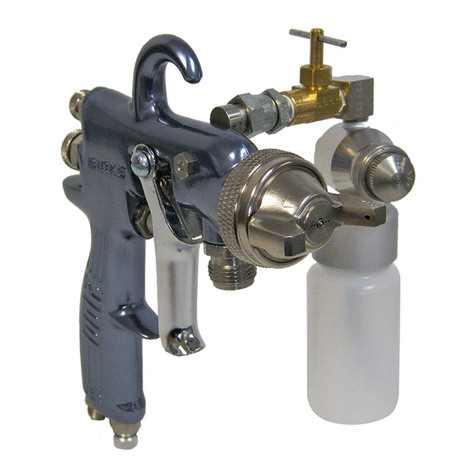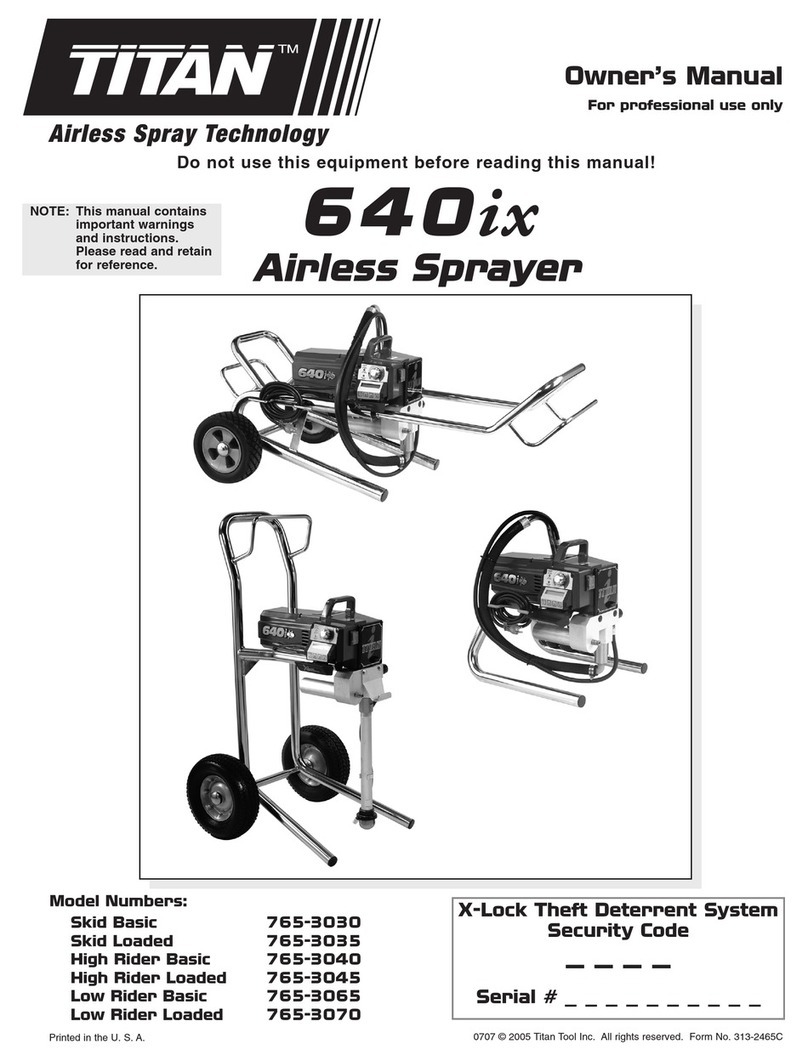NEU MASTER NSG0110-US500 Manual

Model: NSG0110-US500
Electric Spray Gun
MANUAL OF INSTRUCTIONS

————————————————————————
————————————————————————
1
Contents Page
Safety Instruction 2
Product Introduction 4
Operation Instruction——————————————————————5
Clean and Maintenance——————————————————————7
Customer Service & Guarantee———————————————————9
WARNING: READ INSTRUCTIONS MANUAL BEFORE USING PRODUCT.

2
SAFETY INSTRUCTION
SAFETY GULDELINE - DEFINITIONS
It is important for you to read and understand
this manual. The information it contains relates
to protecting YOUR SAFETY and PREVENTING
PROBLEMS. The symbols below are used to
help you recognize this information.
Danger! Indicates an imminently hazardous
situation which, if not avoided, will result in death
or serious injury.
Warning! Indicates a potentially hazardous
situation which, if not avoided, could result in
death or serious injury.
Caution! Indicates a potentially hazardous
situation which, if not avoided, may result in
minor or moderate injury.
Notice! Used without the safety alert symbol
indicates a potentially hazardous situation which,
if not avoided, may result in property damage.
The following are explanations of important
safety hazard pictorials in this manual.
Read and understand the instruction manual.
Fire hazard.
Explosion hazard.
Respiratory hazard
Electric shock hazard.
IMPORTANT SAFETY INSTRUCTIONS
SAVE THESE INSTRUCTIONS: To reduce the
risks of fire or explosion, electrical shock and the
injury to persons, read and understand all
instructions included in this manual. Be familiar
with the controls and the proper usage of the
equipment.
This product is intended for household use only.
Warning! Fire or explosion hazard.
Solvent and spray material fumes can explode
or ignite. Severe injury or property damage can
occur.
To avoid these risks, take the following
preventions:
•
Exhaust and fresh air introduction must
be provided to keep the air within the spray
are free from accumulation of flammable
vapors.
•
Avoid all ignition sources such as
static electricity sparks, open flames, pilot
lights, hot objects, lit tobacco products, and
sparks from connecting and disconnecting
power cords or working light switches.
•
Fire extinguisher equipment shall be
present and working.
•
Keep area clean and free of paint or
solvent containers, rags, and other
flammable material
•
Follow the material and solvent
manufacturer’s safety precautions and
warnings.
•
Do not spray flammable or
combustible materials near an open
flame or sources of ignition such as lit
tobacco products, motors, and electrical
equipment.
•
Know the contents of the spray
materials and their cleaning solvents. Read
all Material Safety Data Sheets (MSDS)
and container labels provided with the
spray materials and solvents. Follow the
spray material and solvent manufacturer’s
safety instructions.
•
Do not smoke in spray area.
•
Do not use materials with a flashpoint
below 21°C (70°F). Flashpoint is the
temperature (see coating supplies).
Flashpoint is the temperature that a liquid
can produce enough vapors to ignite.
Warning! Explosion hazard
due to incompatible materials.
Severe injury orproperty
damage can occur.
To avoid these risks, take the following
preventions:
►Do not use bleach.
►Do not use halog enated
hydrocarbon solvents such as methylene

3
chloride and 1,1,1 Trichloroethane
They are not compatible with aluminum and
may cause an explosion. If you are unsure of
a material’s compatibility with aluminum,
contact your coating supplier.
GENERAL SAFETY WARNINGS
Warning! Hazardous vapors.
Spray materials, solvents, and
other materials can be harmful if
inhaled or come in contact with the body. Vapors
can cause severe nausea, fainting, or poisoning.
To avoid these risks, take the following
preventions:
•
Use a respirator or mask if vapors can be
inhaled. Read all instructions supplied with the
mask to be sure it will provide the necessary
protection.
•
Wear protective eyewear.
•
Wear protective clothing as required by
coating manufacturer.
Warning! Electric shock
hazard. May cause severe injury.
To avoid these risks, take the following
preventions
•
Keep electrical cord plug and sprayer
trigger free from spray material and other
liquids. Never hold cord at plug connections
to support cord. Failure to observe may result
in an electrical shock
•
Never immerse electrical parts in water or
any other liquid. Wipe the exterior of the
sprayer with a damp cloth for cleaning.
Always make sure the sprayer is unplugged
before taking it apart for cleaning.
•
Do not expose unit to rain or wet
conditions.
•
Do not abuse the cord. Never use the
cord to carry the unit or pull the plug from an
outlet. Keep cord away from heat, oil, sharp
edges or moving parts.
•
Replace damaged cords immediately.
Warning! General. To reduce the risk
of severe injury or property damage.
To avoid these risks, take the following
preventions:
•
Do not aim the gun at, or spray any
person, including self, or animal.
•
Do not spray outdoors on windy days
•
Wear protective clothing to keep spray
material off skin and hair.
•
Hose may become hot and cause skin
burn.
•
Follow all appropriate local, state, and
national codes governing ventilation, fire
prevention, and operation.
•
Always use appropriate gloves, eye
protection and a respirator or mask when
spraying, thinning, mixing, pouring, or
cleaning.
•
Do not operate or spray near children.
Keep children away from equipment at all
times. Keep sprayer out of the reach of
children.
•
Do not overreach or stand on an unstable
support. Keep effective footing and balance at
all times.
•
Stay alert and watch what you are doing.
Do not operate the unit when fatigued or under
the influence of drugs or alcohol.
•
Read all instructions and safety precautions
for equipment and spray m aterial before
operating any equipment.
•
Hearing protection is recommended
for extended use.
ELECTRICAL SAFETY
This tool is double insulated, therefore
no earth wire is required. Always
check that the power supply corresponds to
the voltage on the rating plate.
•
If the supply cord is damaged, it must be
replaced by the manufacturer or an
authorized Service Centre in order to avoid a
hazard.
•
When using the tool outdoors, only use

4
extension cables intended for outdoor use. A
suitable rated extension cable of up to 30
meters can be used without loss of power
•
Electric safety can be further improved by
using a high sensitivity.
TECHNICAL DATA
EXTENSION CORD
When using an extension cord, be sure to use
one heavy enough to carry the current your
product will draw. An undersized cord will cause
a drop in line voltage resulting in loss of power
and overheating.
If an extension cord is to be used outdoors,
it must be marked with the suffix W-A after the
cord type designation. For example, a
designation of SJTW-A would indicate that
the cord would be appropriate for outdoor
use.
For proper size cords see chart guide for
extension cord usage.
Type of
cable
Up to 5
meters
from 5 to
10 meters
Parallel
18AWG
16AWG
Warning! Some spray materials
contain chemicals known to the State of
California to cause cancer, birth defects or
other reproductive harm. To reduce your
exposure wear appropriate safety equipment
such as face masks, gloves, and other
appropriate protective equipment. Please
review and follow the safety precautions on the
paint container.
PRODUCT INTRODUCTION
SET – UP
Warning! Be sure to use appropriate
protective gear and unplug unit.
Warning! Make sure area is well ventilated
and free of flammable vapors.
Never point the spray gun at any part of the
body.
1. Find and aim at the “lock” position on the main
housing assembly, and insert the spray gun
into the main housing assembly into place.
Then turn to the end as clockwise direction
2. Turn the buckle on main housing to lock the
gun set into place.
Aligning the pickup tube (Suction tube)
Note: By pointing the pickup tube in the proper
direction, you will not have to refill the canister as
often.
If you are going to be spraying in a downward
direction, the angled end of the pickup tube
Flow Rate 900 ml/min
Max. Viscosity
100 DIN-s
(runout time: 100 seconds)
Voltage
120 V
Current 4.0 A
Canister
Capacity
1200 ml
Nut Air cap Nozzle
Viscosity cup
Cleaning Needle
Hook Filter housing
Container
Trigger
Material adjustment
knob
Main housing
Handle

5
should be pointing toward the front of gun
If you are going to be spraying in an upward
direction. The angled end of the pickup tube
should be pointing toward the rear of the gun.
MATERIAL PREPARATION
Liquid material preparation Tip:
Make sure the type of material you use can be
cleaned with either mineral spirits or paint thinner
(for oil-based paints) or a warm water and soap
solution (for water soluble paints like latex). Use
drop cloths during pouring, mixing, and viscosity
testing of materials to be sprayed to protect your
floors and anything else in the spraying area that
you wish to remain untouched.
The liquid being sprayed may need to be thinned
(diluted) before starting. When thinning, use the
proper liquid thinner recommended on the container
by the material Manufacturer.
Warning! Do not use materials with a
flashpoint below than 21°C (70°F).
A viscosity test cup is provided to determine the
“runout time” of the material being used.
1. Before measuring for the proper viscosity,
stir the material thoroughly.
2. Dip the viscosity cup into the material
being sprayed and fill the cup completely.
3. With the cup held over the material container,
measure the amount of time it takes for the
stream of material flowing out to “break” or
stop being a constant stream out of the
bottom of the cup (100 seconds or less).
This is the “runout time”. Refer to the thinning
table below for information on the thinning
required for different materials. If material needs
thinning, add the appropriate liquid thinning
material recommended by the manufacturer.
Thinning table
Note: It is possible to spray latex paint with this
unit, however, the required thinning may exceed
material manufacturer’s recommendation.
Thin latex paint so that it runs through viscosity
cup within100 seconds. The operator should
consider the type of application and final location
of the project when spraying a material that
requires more than 100 seconds to run through
the viscosity cup.
OPERATION INSTRUCTION
Preparation tips
Always stir and strain the material thoroughly
before use. If need, please use the included
paper filter to filter out the impurities.
With any spraying job you should always ensure
that you have properly prepared the surface to
get the best finish. That is, all surface are free
from dust, dirt, rust and grease. Lightly pressure
wash decks or exterior surfaces and ensure that
they are dry before spraying.
Even though HVLP sprayers have very little
overspray, it is recommended that you mask all
edges and other areas and use drop cloths to
protect your floors and anything else in the
spraying area that you wish to remain
Material
Runout Time
1
Oil Enamel
25-40
2
Oil based primer
30-45
3
Oil stain
No thinning required
4
Clear sealer
No thinning required
5
Polyurethane
No thinning required
6
Varnish
20-50
7
Lacquer sanding
sealer
25-35
8
Lacquer
25-35
9
Automotive finishes
20-40
10
Latex paint
Follow manufacture’s
recommendations

6
untouched.
Skin that forms on the top of paint can clog the
sprayer. Remove skin before mixing. Strain with
a funnel with a filter attached or through hosiery
to remove any impurities that could clog system.
Before starting have gloves, paper towels, rags
etc. available for unexpected spills.
Filing the Canister
1. Unscrew the Canister. Stand the canister on a
smooth and horizontal surface.
2. Pour the properly thinned and strained
material to be sprayed into the canister.
3. Clean any residual liquid from the threads or
sides of the canister and sprayer.
4. Starting the threads evenly, screw the lid,
completely onto the top fill canister. Check
the lidtomake sure it is threaded on
squarely and completely before picking up
the sprayer.
Adjust Spray Pattern
The spray pattern shape is adjusted by turning
the ears of the air cap to either the vertical,
horizontal, or diagonal position. The position of
the air cap and the corresponding spray pattern
shape are shown below.
Material Flow Adjustment
Set the material volume by turning the regulator
on the trigger of the spray gun.
Turn to “+” mark direction increase the flow of
liquid and turn to “-“ direction decrease the flow of
liquid.
For thicker materials, it is recommended that you
start with the highest material flow setting and
then gradually decrease the flow to suit your
particular spraying needs.
For thinner materials, it is recommended that you
start with a low material flow setting and then
gradually increase the flow to suit your particular
spraying needs.
Always test the spray pattern on scrap cardboard
or similar material first, Begin with flow control
knob on highest flow setting. If less flow is
desired, dial the flow control knob to decrease the
flow of liquid.
Heavier, thicker material should be sprayed with
the flow control knob on high flow setting.
Thinner material should be sprayed with the flow
control knob on low flow setting.
Proper Spraying Technique
If spraying with an HVLP spray system is new or
unfamiliar to you. It is advisable to practice on a
piece of scrap wood or cardboard before
beginning on your intended workpiece.
Surface Preparation
All objects to be sprayed should be thoroughly
cleaned before spraying material on them. Areas
not to be sprayed may, in certain cases, need to
be masked or covered.
Spray Area Preparation
The spray area must be clean and free of dust in
order to avoid blowing dust onto your freshly
sprayed surface.
Nozzle size pickup
Select right size of nozzle base upon the material
you are going to use and the surface targeting
finishing. The small size of nozzle reflected to
finer coating. Dilute material if needed for better
quality of the coating
Nozzle
size
Recommended
material
Project Example
1.5mm
(White)
sealers, stains,
enamel,
varnish, dyes
Table, chair, bicycle,
shutter, cabinets,
wooden toy, model
2.0mm
(Red)
polyurethane,
chalk and milk
type paint
Railings, multi-frame
window frames,
heating pipes, boats,
yard furniture, garage
doors, metal garden
fences.
2.5mm
(Black)
low viscosity
primer, wall
paint
Internal wall, wooden
garden fence, wooden
pile, corridor
3.0mm
(Grey)
Latex plus
primers,
primer, wall
paint, latex, oil
enamels
External walls, outdoor
floors, deck
Nut
Air cup

7
Never trying spray material which viscosity higher
than the spray gun can withstand, NSG0110
viscosity spec at MAX 100-DINs
HOW TO SPRAY PROPERLY
Position the spray gun perpendicular to and 2 or
more inches from the spray surface, depending on
the spray pattern size desired
Spray parallel to the surface with smooth passes
at a consistent speed as shown below. Doing this
will avoid irregularities in the finish. (.i.e runs and
sags)
Always apply a thin coat of material on the first
pass and allow to dry before applying a second,
slightly heavier coat.
Keep stroke smooth and at an even speed
Always spray area from a minimum of 50mm (2
inches) to a maximum of 300mm (12 inches).To
get an even spray distribution. Always keep your
arm at the same distance from the surface you are
spraying and avoid flex wrist while spraying
When spraying, always trigger the spray gun after
spray pass has begun and release trigger before
stopping the pass. Always keep the gun pointed
squarely at the spray surface and overlap passes
slightly to obtain the most consistent and
professional finish possible.
Light coat Heavy coat light coat
When you quit spraying for any length of time, turn
the power unit OFF and place the spray gun into
the built-in dock on the power unit.
A commonly used method for spraying a large
surface is the “crisscross” pattern. This is done by
spraying in horizontal strips and then crossing
over these strips with vertical strips.
Avoid spraying too heavily in any one area. Several
lighter coats are better than one heavy coat which
can lead to running and dripping. Remember that
the flow control knob regulates the amount of liquid
that can be sprayed. If runs or drips do occur, have
a dry paint brush on hand to smooth them out.
CLEAN AND MAINTENANCE
Before you begin:
When cleaning, use the appropriate cleaning
solution (warm, soapy water for water-based
material like latex; mineral sprits for oil-based
material)
Special cleanup instruction for use with
flammable solvents (must have a flashpoint
above 70°F (21°C)
•
Always flush spray gunoutside
•
Area must be free of flammable vapors
•
Cleaning area must be well-ventilated
•
Do not submerge power unit
1. Unplug tool. Trigger the spray gun so that the
material inside the spray gun flows back into
the canister
2. Unscrew the canister. Empty any remaining
material back into the material container.
3. Pour a small amount of the appropriate
cleaning solution into the canister. Clean
canister and pickup tube and properly dispose
of cleaning solution. Refill the canister with
NEW cleaning solution.

8
4. Attach the canister to the gun, plug in the cord.
5. Spray the solution through the gun for 2 or 3
seconds in a safe area. Unplug tool and trigger
the spray gun so that the material inside the
spray gun flows back to canister. Wipe the
exterior of the cup and gun until clean.
6. Unscrew nut, air cap, nozzle, pickup tube. (If
there is any paint within the see-through check
valve tube, teardown the check valve for
cleaning.)
7. Clean the canister, pickup tube, air cap, nut
and nozzle with a cleaning brush and
appropriate cleaning solution.
IMPORTANT: Never clean nozzle or air channel
in the spray gun with sharp metal objects. Do not
use solvents or lubricants containing silicone.
8. Twist and separate the spray
gun from the handle. Clean
the rear of the spray gun (a)
with the appropriate cleaning
solution. Use a thin layer of
petroleum jelly to lubricate
the O-ring (b).
9. Dry all parts thoroughly.
10.Place a drop of household oil into the inside of
the sprayer from the hole for assembling the
spray tip.
11.Reassemble spray gun
Note: Spray nozzle can only be assembled in one
direction that the notch of the nozzle must align
with the skirt on spray unit housing.
Note: The spray tip must be assembled in the
sprayer with the bumps on the spray tip in vertical
direction.
Note: Assemble the pickup tube by firmly pushing
them onto the inlet in the spray.
Attention!
The check valve muse be put back in place by
right direction with nipper point upward.
Otherwise, tool might get slog very easily. If
check valve is damaged or missing, please
replace with new one (3x included)
MAINTENANCE
Use only mild soap and damp cloth to clean
the power unit.
Never let any liquid get inside the power unit.
Never immerse any part of the power unit
into a liquid.
Important! To assure product SAFETY
and RELIABILITY, repairs, maintenance
and adjustment (other than those listed
in this manual) should be performed by
authorized service centers or other
qualified service personnel, always
using identical replacement parts.
The power unit contains washable / reusable
filter. Check the filter before and after each
use. If dirty, wash with warm water and
allow to air dry before re-installing or replace
it if it is excessively dirty by below two steps.
1. Press at the middle tap area on each
side of filter cover as arrow pointed to

9
remove the filter cover.
2. Replace the dirty filter from the power
unit and replace with new ones.
3. Secure the covers back onto the power
unit.
IMPORTANT: Never operate your unit without the
air filter. Dirt could be sucked in and interfere with
the function of the unit.
STORAGE
Make sure unit is clean and dry before storing.
Store unit indoors in a dry location, to prevent
damage, wrap the electrical cord so that it is not
crimped during storage.
CUSTOMER SERVICE &
GUARANTEE
ACCESSORIES
Recommended accessories for use with your
product are available from your local dealer or
authorized service center.
Warning: The use of any accessory not
recommended for use with this product could be
hazardous.
PROTECTING THE ENVIRONMENT
Separate collection. This product must
not be disposed of with normal
household waste. Should you find one
day that your product needs
replacement, or if it is of no further use
to you. Do not dispose of it with household waste.
Make this product available for separate
collection.
Separate collection of used products
and packaging allows materials to be
recycled and used again. Re-use of
recycled materials helps prevent environmental
pollution and reduces the demand for raw
materials. Local regulations may provide for
separate collection of electrical products from the
household, at municipal waste sites or by the
retailer when you purchase a new product
PART LIST
Part #
Part Description
Quantity
1
Nut
1
2
Air Cap
1
3
Nozzle (
Φ
1.5, 2.0, 2.5,
3.0 mm )
4
4
Spray tip
1
5
Power unit housing
1
6
Trigger
1
7
Check valve tube seat
1
8
Material flow adjust
knob
1
9
Check valve tube
1
10
Check valve seat
1
11
Check valve
1
12
Check valve sleeve
1
13
Suction tube
1
14
Sealing cup
1
15
Canister
1
16
Quick release lock
1
17
Filter
1
18
Left filter cover
1
19
Right filter cover
1
20
Viscosity cup
1
21
Cleaning needle
1
22
Cleaning brush
1


11
TROUBLE! MATERIAL BEING SPRAYED IS SPLATTERING
WHAT’S WRONG?
WHAT TO DO…
Viscosity of material is too high. Thin material per manufacturer recommendation.
Set at too high volume at very beginning.
Set flow rate at lower as start.
Paint not been stirred thoroughly.
Stir the material thoroughly.
TROUBLE! ATOMIZATION IS TOO COARSE
WHAT’S WRONG? WHAT TO DO…
Viscosity of material too high.
Thin material per manufacturer recommendation.
Flow control knob setting too high. Decrease flow control setting.
Material accumulated /clog inside nozzle. Clean.
Air inlet blocked. Clean or change air filter.
Canister loose. Screw canister tightly in place.
TROUBLE! SPRAYER PULSATES.
WHAT’S WRONG?
WHAT TO DO…
Air filter clogged.
Clean or change air filter.
Material in canister almost empty. Refill canister.
Canister loose. Screw canister tightly in place.
TROUBLE! SPRAY MATERIAL DOES NOT COVER PROPERLY
WHAT’S WRONG? WHAT TO DO…
Flow control knob setting too low.
Increase flow control setting.
Clearance to target area too large. Reduce spray distance.
Too few spray paths sprayed over target area. Apply more spray paths sprayed over target
area.
Viscosity of material too high. Thin material per manufacturer recommendation.
Have you tried the recommendations above and are still having problems?
In the United States, to contact to a customer service representative, mail our Technical
Service at spartartool@gmail.com 24/7 or Facebook Page NEU MASTER TOOL. We will
get back to you within 24 hours.
Other manuals for NSG0110-US500
1
Table of contents
Other NEU MASTER Paint Sprayer manuals
